The hydrocarbon cleaning agents market, valued at USD 2,581.6 million in 2025 and anticipated to reach USD 4,623.2 million by 2035, demonstrates a steady CAGR of 6.0%. The initial market phase from 2025 to 2027 indicates a gradual rise from USD 2,581.6 million to USD 2,900.6 million, reflecting the early adoption of hydrocarbon-based cleaning solutions across industrial and manufacturing sectors. Demand is primarily driven by end-use industries such as automotive, aerospace, and electronics, where precision cleaning is essential for operational efficiency. During this period, incremental growth is supported by regulatory compliance requirements and the shift from traditional solvents to hydrocarbon formulations due to improved environmental and safety profiles.
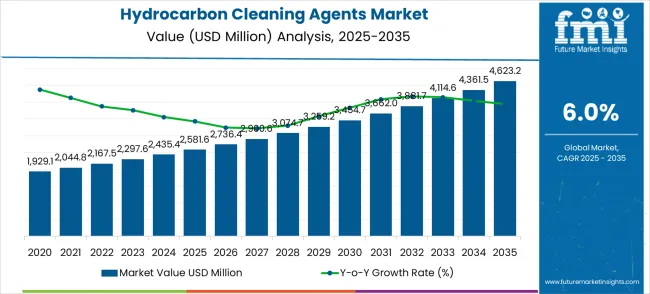
Between 2027 and 2030, the market experiences its first significant breakpoint, with growth accelerating from USD 2,900.6 million to USD 3,454.7 million. This breakpoint reflects increased adoption in high-value industrial applications where hydrocarbon cleaning agents offer superior residue-free cleaning and compatibility with advanced materials. Manufacturers focus on product innovation, introducing specialty formulations with enhanced biodegradability and reduced VOC content, further driving adoption. Rising industrial automation and precision manufacturing needs amplify demand, creating a sharper slope in the market trajectory.
| Item | Value |
|---|---|
| Market Value (2025) | USD 2,581.6 million |
| Market Forecast Value (2035) | USD 4,623.2 million |
| Market Forecast CAGR | 6.0% |
From 2030 to 2033, a second breakpoint emerges, marked by growth from USD 3,454.7 million to USD 4,114.6 million. This phase indicates a maturing market segment in developed regions, while emerging markets continue to adopt hydrocarbon cleaning agents at an accelerated pace. Market penetration is enhanced through strategic partnerships with industrial distributors and OEMs, enabling wider accessibility and standardized use in critical cleaning processes. Price stabilization and optimized supply chains contribute to sustained adoption rates, reinforcing the structural stability of the market beyond early-stage growth.
The final phase from 2033 to 2035 shows the market reaching USD 4,623.2 million, with a moderate yet consistent growth pattern. The market curve flattens slightly as the industry approaches saturation in key developed economies, while emerging regions drive incremental growth. Breakpoints throughout the decade highlight critical periods where technological innovation, regulatory alignment, and industrial expansion intersect, shaping the overall growth profile. This analysis aids manufacturers and stakeholders in identifying high-impact periods for strategic investments, production scaling, and targeted marketing efforts within the hydrocarbon cleaning agents landscape.
Hydrocarbon Cleaning Agents Market Opportunity Pools
The Hydrocarbon Cleaning Agents market is entering a phase of steady growth, driven by demand for industrial cleaning solutions, manufacturing expansion, and evolving environmental and safety standards. By 2035, these pathways together can unlock USD 920-1,220 million in incremental revenue opportunities beyond baseline growth.
Pathway A -- Automotive Manufacturing Leadership (Parts & Assembly Cleaning) The automotive segment already holds the largest share due to its extensive cleaning requirements and quality standards. Expanding electric vehicle production, precision manufacturing, and assembly line optimization can consolidate leadership. Opportunity pool: USD 310-420 million.
Pathway B -- Normal Hydrocarbon Innovation (Environmental Compliance) Normal hydrocarbons account for the largest share due to performance advantages. Growing industrial focus on environmental compliance and worker safety will drive higher adoption of advanced normal hydrocarbon formulations. Opportunity pool: USD 250-340 million.
Pathway C -- Electronics & Precision Manufacturing Growth Electronic components and precision manufacturing markets are expanding, especially with semiconductor and advanced technology production. Cleaning agents designed for sensitive electronics can capture significant growth. Opportunity pool: USD 160-220 million.
Pathway D -- Emerging Market Expansion Asia-Pacific, Latin America, and Africa present growing demand due to rising industrial manufacturing and environmental awareness. Targeting manufacturing facilities and chemical distributors will accelerate adoption. Opportunity pool: USD 120-170 million.
Pathway E -- Aerospace & High-Tech Applications With advancing aerospace technologies and high-precision manufacturing, there is opportunity to develop specialized cleaning agents for critical applications requiring ultra-clean components. Opportunity pool: USD 80-120 million.
Pathway F -- Eco-friendly & Bio-Based Formulations Growing environmental focus creates opportunities for bio-based and renewable hydrocarbon cleaning agents offering enhanced green profiles. Opportunity pool: USD 60-90 million.
Pathway G -- Maintenance & MRO Services Industrial maintenance, repair, and overhaul services create opportunities for specialized cleaning formulations designed for equipment maintenance applications. Opportunity pool: USD 40-60 million.
Pathway H -- Custom Formulation & Technical Services Specialized formulation services, application engineering, and technical support create value-added opportunities for complex industrial cleaning challenges. Opportunity pool: USD 20-30 million.
Why is the Hydrocarbon Cleaning Agents Market Growing?
Market expansion is being supported by the rapid increase in industrial manufacturing worldwide and the corresponding need for high-performance cleaning solutions that provide superior degreasing performance and environmental compliance. Modern manufacturing operations rely on consistent equipment cleanliness and maintenance efficiency to ensure optimal production quality including automotive manufacturing, electronics assembly, and aerospace component production. Even minor contamination issues can require comprehensive cleaning protocol adjustments to maintain optimal operational standards and product quality.
The growing complexity of manufacturing cleaning requirements and increasing demand for environment friendly cleaning solutions are driving demand for hydrocarbon cleaning agents from certified manufacturers with appropriate chemical formulation capabilities and environmental expertise. Manufacturing companies are increasingly requiring documented cleaning effectiveness and environmental compliance to maintain production quality and regulatory adherence. Industry specifications and environmental standards are establishing standardized cleaning procedures that require specialized hydrocarbon technologies and trained cleaning professionals.
The market is segmented by hydrocarbon type, application, and region. By hydrocarbon type, the market is divided into normal hydrocarbons, isomeric hydrocarbons, cycloalkanes, and aromatic hydrocarbons. Based on application, the market is categorized into automotive, electronic components, aerospace, and others. Regionally, the market is divided into North America, Europe, East Asia, South Asia & Pacific, Latin America, and Middle East & Africa.
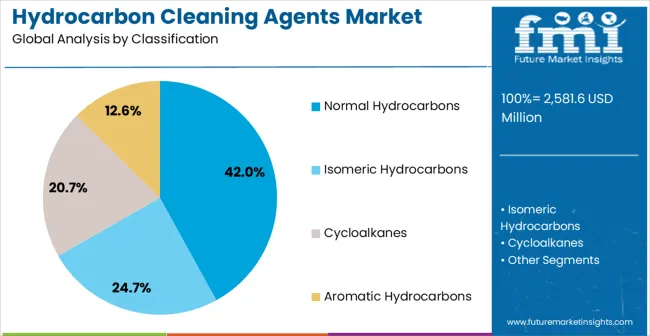
In 2025, the normal hydrocarbons segment is projected to capture around 42% of the total market share, making it the leading product category. This dominance is largely driven by the widespread adoption of straight-chain hydrocarbon solvents that provide optimal cleaning performance and environmental compatibility, catering to a wide variety of industrial degreasing applications. The normal hydrocarbon formulation is particularly favored for its ability to deliver effective solvent cleaning with predictable evaporation rates and consistent performance characteristics, ensuring operational reliability. Manufacturing facilities, automotive plants, electronics manufacturers, and maintenance operations increasingly prefer normal hydrocarbon solutions, as they meet diverse cleaning requirements without imposing excessive environmental compliance complexity or safety concerns. The availability of well-established production processes, along with comprehensive environmental certifications and technical support from leading chemical manufacturers, further reinforces the segment's market position. This hydrocarbon type benefits from consistent demand across regions, as it is considered a versatile solution for industrial facilities requiring reliable cleaning performance with environmental compliance. The combination of cleaning effectiveness, environmental compatibility, and operational reliability makes normal hydrocarbon cleaning agents a preferred choice, ensuring their continued dominance in the industrial solvent market.
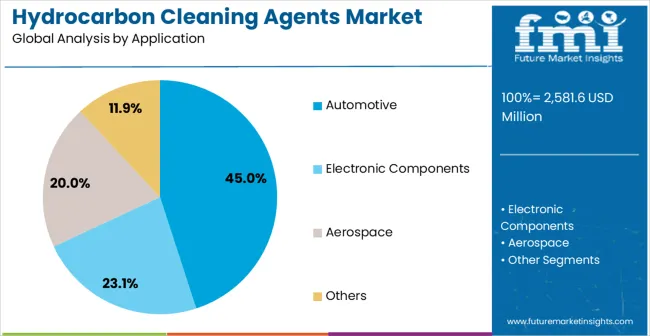
The automotive segment is expected to represent 45% of hydrocarbon cleaning agent demand in 2025, highlighting its position as the most significant application sector. This dominance stems from the extensive use of cleaning agents in automotive manufacturing and maintenance operations, where effective degreasing and parts cleaning are critical to assembly quality and operational efficiency. Automotive applications often require specialized cleaning solutions that can remove various contaminants throughout different manufacturing stages and maintenance procedures, requiring high-performance and consistent cleaning agents. Hydrocarbon cleaning agents are particularly well-suited to automotive environments due to their excellent degreasing capabilities and ability to effectively clean automotive components without damaging sensitive materials or coatings, even in high-volume production scenarios. As global automotive production continues to expand and manufacturers focuses improved quality control and operational efficiency standards, the demand for hydrocarbon cleaning agents continues to rise. The segment also benefits from increased focus within the automotive industry, where manufacturers are increasingly prioritizing cleaning effectiveness and environmental compliance as essential elements of green manufacturing operations. With automotive facilities requiring comprehensive parts cleaning and maintenance capabilities, hydrocarbon cleaning agents provide an essential solution to maintain effective production processes while ensuring consistent component quality and environmental responsibility. The growth of electric vehicle manufacturing, coupled with increased focus on precision assembly and environment friendly, ensures that automotive applications will remain the largest and most stable demand driver for hydrocarbon cleaning agents in the forecast period.
The market is advancing steadily due to increasing industrial manufacturing development and growing recognition of hydrocarbon cleaning advantages over traditional chlorinated and aqueous cleaning systems. The market faces challenges including higher material costs compared to conventional solvents, need for proper ventilation and safety systems, and varying environmental regulations across different industrial jurisdictions. Environmental compliance efforts and formulation advancement programs continue to influence product development and market adoption patterns.
The growing development of advanced environmentally compliant hydrocarbon formulations is enabling superior cleaning performance with improved environmental safety characteristics and reduced regulatory complexity. Enhanced formulation technologies and optimized hydrocarbon purification processes provide effective cleaning performance while maintaining environmental compliance and worker safety requirements. These technologies are particularly valuable for manufacturing facilities that require consistent cleaning performance supporting demanding industrial applications with reliable environmental compliance results.
Modern hydrocarbon cleaning agent manufacturers are incorporating advanced specialized features and application-specific formulations that enhance cleaning effectiveness and operational efficiency. Integration of advanced additive systems and optimized solvent blends enables superior cleaning performance and comprehensive contamination removal capabilities. Advanced specialized features support use in diverse manufacturing environments while meeting various cleaning requirements and application specifications.
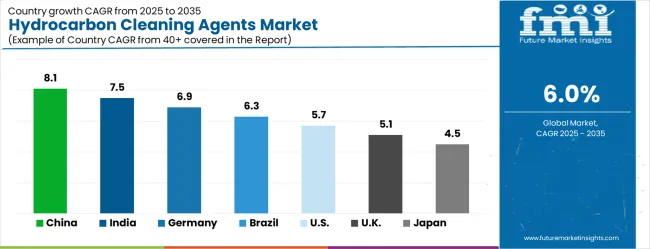
| Country | CAGR (2025–2035) |
|---|---|
| China | 8.1% |
| India | 7.5% |
| Germany | 6.9% |
| Brazil | 6.3% |
| United States | 5.7% |
| United Kingdom | 5.1% |
| Japan | 4.5% |
The market is growing steadily, with China leading at a 8.1% CAGR through 2035, driven by massive industrial manufacturing expansion and increasing adoption of advanced cleaning technologies. India follows at 7.5%, supported by rising automotive and electronics manufacturing development and growing awareness of effective cleaning solutions. Germany grows strongly at 6.9%, integrating hydrocarbon cleaning technology into its established manufacturing and automotive infrastructure. Brazil records 6.3%, focusing industrial modernization and manufacturing efficiency enhancement initiatives. The United States shows solid growth at 5.7%, focusing on environmental compliance and cleaning technology innovation. The United Kingdom demonstrates steady progress at 5.1%, maintaining established industrial manufacturing applications. Japan records 4.5% growth, concentrating on technology advancement and cleaning precision optimization.
The report covers an in-depth analysis of 40+ countries; top-performing countries are highlighted below.
China is projected to grow at a CAGR of 8.1% between 2025 and 2035, driven by the expanding industrial and automotive sectors. High demand for metal degreasing, precision cleaning, and surface preparation applications has reinforced adoption. Leading domestic companies such as Sinopec and CNOOC have focused on producing environmentally compliant, high-performance hydrocarbon cleaning agents. Industrial clients increasingly prefer solvents with low residue and high efficiency to improve operational productivity. Strategic partnerships with international suppliers have facilitated technology transfer and large-scale deployment. The demand is further supported by rising manufacturing automation and adoption of advanced machinery requiring high-quality cleaning agents for maintenance and production efficiency.
India is forecasted to grow at a CAGR of 7.5% between 2025 and 2035, supported by growth in manufacturing, automotive, and electronics industries. Industrial cleaning applications such as degreasing and equipment maintenance have increased demand for hydrocarbon-based solvents. Domestic players like Balmer Lawrie and Tata Chemicals are focusing on producing cost-effective and efficient cleaning agents. Growing adoption in precision cleaning for electronics and automotive components is shaping market trends. Urban industrial hubs and free-trade zones have become primary adoption zones. Regulatory initiatives promoting safe handling and environmentally friendly cleaning solutions further reinforce growth.
Germany is expected to grow at a CAGR of 6.9% between 2025 and 2035, driven by advanced manufacturing, automotive, and metal processing industries. High standards of industrial cleanliness and environmental regulations have influenced the adoption of high-purity hydrocarbon cleaning agents. Leading manufacturers such as BASF and Henkel have introduced eco-friendly, low-residue solvents tailored for precision cleaning. Industrial clients prefer agents that enhance equipment lifespan and reduce maintenance downtime. Research and development initiatives have focused on green formulations without compromising cleaning efficiency. Adoption is further supported by stringent industrial compliance standards across automotive and mechanical engineering sectors.
Brazil is projected to grow at a CAGR of 6.3% between 2025 and 2035, driven by rising demand in manufacturing, automotive, and oil and gas sectors. Industrial maintenance and surface cleaning applications require high-performance hydrocarbon agents. Companies such as Braskem and Oxiteno have introduced advanced cleaning solutions suitable for diverse industrial processes. Growing adoption in automotive workshops and industrial plants has expanded market penetration. Regulatory guidelines on solvent handling and safety compliance are supporting market growth. Industrial clients are increasingly focusing on low-residue, high-efficiency agents to improve equipment reliability and reduce operational costs.
The United States is expected to grow at a CAGR of 5.7% from 2025 to 2035, influenced by the automotive, aerospace, and electronics industries. Industrial clients prefer hydrocarbon-based cleaning agents for degreasing, precision maintenance, and component preparation. Companies such as ExxonMobil and Chevron have introduced high-purity, low-residue solvents for industrial applications. Adoption is driven by stringent quality standards, environmental compliance, and efficiency in equipment maintenance. Industrial plants, manufacturing hubs, and aerospace maintenance facilities are primary deployment areas. Continuous product innovation in eco-friendly and high-performance cleaning agents reinforces long-term market growth in the USA
The United Kingdom is forecasted to grow at a CAGR of 5.1% between 2025 and 2035, supported by demand in industrial maintenance, automotive workshops, and electronics manufacturing. Companies such as Croda and Johnson Matthey have launched eco-friendly, high-efficiency hydrocarbon cleaning solutions. Industrial clients prioritize solvent performance, residue reduction, and equipment protection. Adoption is reinforced by environmental regulations and increasing focus on green manufacturing practices. Growth is also influenced by investments in industrial plants and manufacturing automation. The market has witnessed rising use of hydrocarbon agents for precision cleaning of components and equipment maintenance across multiple sectors.
Japan is projected to grow at a CAGR of 4.5% between 2025 and 2035, influenced by high standards in electronics, automotive, and precision manufacturing industries. Hydrocarbon cleaning agents are widely adopted for degreasing, surface preparation, and equipment maintenance. Companies such as Mitsubishi Chemical and Showa Denko have developed high-performance, low-residue, and environmentally compliant solvents. Adoption is concentrated in urban industrial hubs and high-tech manufacturing facilities. Focus on regulatory compliance and efficiency in industrial operations reinforces market growth. Continuous innovation in formulation and cleaning efficiency positions Japan as a steady growth market for hydrocarbon cleaning agents over the forecast period.
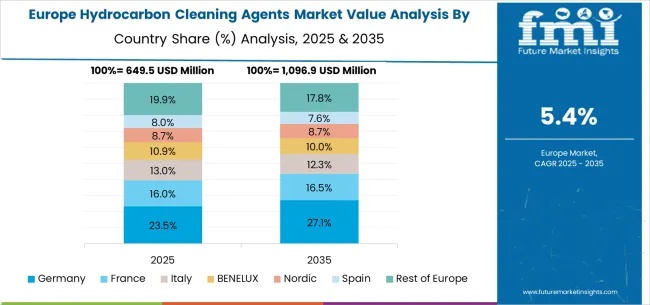
The hydrocarbon cleaning agents market in Europe is forecast to expand from USD 692.0 million in 2025 to USD 1,239.2 million by 2035, registering a CAGR of 6.0%. Germany will remain the largest market, holding 34.0% share in 2025, easing to 33.5% by 2035, supported by strong manufacturing infrastructure and advanced industrial cleaning systems. The United Kingdom follows, rising from 26.0% in 2025 to 26.5% by 2035, driven by manufacturing companies and industrial innovation initiatives. France is expected to decline slightly from 22.0% to 21.5%, reflecting industrial consolidation pressures. Italy maintains stability at around 14.0%, supported by manufacturing facilities and industrial cleaning centers, while Spain grows from 3.5% to 4.0% with expanding manufacturing and industrial cleaning demand. BENELUX markets ease from 0.4% to 0.3%, while the remainder of Europe hovers near 0.1%--0.2%, balancing emerging Eastern European growth against mature Nordic markets.
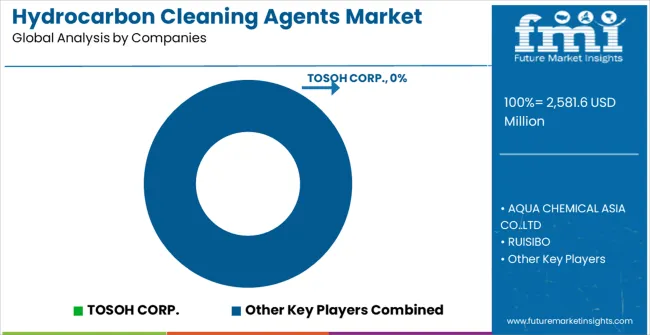
The market is defined by competition among specialized chemical manufacturers, industrial solvent companies, and cleaning solution providers. Companies are investing in advanced hydrocarbon formulation development, cleaning performance optimization, environmental compliance improvements, and comprehensive technical support capabilities to deliver reliable, effective, and environmentally compliant cleaning solutions. Strategic partnerships, technological innovation, and market expansion are central to strengthening product portfolios and industrial presence.
TOSOH CORP. offers comprehensive hydrocarbon cleaning agent solutions with established chemical manufacturing expertise and industrial-grade solvent capabilities. AQUA CHEMICAL ASIA CO., LTD provides specialized industrial cleaning chemicals with focus on performance effectiveness and environmental compliance. RUISIBO delivers advanced cleaning solutions with focus on manufacturing optimization and application versatility.
ENEOS Corporation offers professional-grade hydrocarbon solvents with comprehensive industrial support capabilities. Bio-Organic Catalyst Inc. delivers established cleaning solutions with advanced environmental technologies. SHELL provides specialized hydrocarbon products with focus on industrial precision optimization. NANJING KERUN LUBRICANTS CO., LTD., ExxonMobil, Jayne Products, RB Products Inc., Jumbo, SUMICO, NS Clean, NCC Co., Ltd., and PETROFER offer specialized manufacturing expertise, cleaning reliability, and comprehensive product development across global and regional industrial cleaning market segments.
| Item | Value |
|---|---|
| Quantitative Units | USD 2,581.6 Million |
| Hydrocarbon Type | Normal Hydrocarbons, Isomeric Hydrocarbons, Cycloalkanes, Aromatic Hydrocarbons |
| Application | Automotive, Electronic Components, Aerospace, Others |
| Regions Covered | North America, Europe, East Asia, South Asia & Pacific, Latin America, Middle East & Africa |
| Country Covered | China, India, Germany, Brazil, United States, United Kingdom, Japan, and 40+ countries |
| Key Companies Profiled | TOSOH CORP., AQUA CHEMICAL ASIA CO., LTD, RUISIBO, ENEOS Corporation, Bio-Organic Catalyst Inc., SHELL, NANJING KERUN LUBRICANTS CO., LTD., ExxonMobil, Jayne Products, RB Products Inc., Jumbo, SUMICO, NS Clean, NCC Co., Ltd., PETROFER |
| Additional Attributes | Dollar sales by hydrocarbon type and application segment, regional demand trends across major markets, competitive landscape with established chemical manufacturers and emerging cleaning technology providers, customer preferences for different hydrocarbon types and industrial applications, integration with manufacturing systems and cleaning protocols, innovations in hydrocarbon formulation effectiveness and environmental compliance technologies, and adoption of specialized cleaning features with enhanced performance capabilities for improved industrial cleaning workflows. |
The global hydrocarbon cleaning agents market is estimated to be valued at USD 2,581.6 million in 2025.
The market size for the hydrocarbon cleaning agents market is projected to reach USD 4,623.2 million by 2035.
The hydrocarbon cleaning agents market is expected to grow at a 6.0% CAGR between 2025 and 2035.
The key product types in hydrocarbon cleaning agents market are normal hydrocarbons, isomeric hydrocarbons, cycloalkanes and aromatic hydrocarbons.
In terms of application, automotive segment to command 45.0% share in the hydrocarbon cleaning agents market in 2025.






Our Research Products

The "Full Research Suite" delivers actionable market intel, deep dives on markets or technologies, so clients act faster, cut risk, and unlock growth.

The Leaderboard benchmarks and ranks top vendors, classifying them as Established Leaders, Leading Challengers, or Disruptors & Challengers.

Locates where complements amplify value and substitutes erode it, forecasting net impact by horizon

We deliver granular, decision-grade intel: market sizing, 5-year forecasts, pricing, adoption, usage, revenue, and operational KPIs—plus competitor tracking, regulation, and value chains—across 60 countries broadly.

Spot the shifts before they hit your P&L. We track inflection points, adoption curves, pricing moves, and ecosystem plays to show where demand is heading, why it is changing, and what to do next across high-growth markets and disruptive tech

Real-time reads of user behavior. We track shifting priorities, perceptions of today’s and next-gen services, and provider experience, then pace how fast tech moves from trial to adoption, blending buyer, consumer, and channel inputs with social signals (#WhySwitch, #UX).

Partner with our analyst team to build a custom report designed around your business priorities. From analysing market trends to assessing competitors or crafting bespoke datasets, we tailor insights to your needs.
Supplier Intelligence
Discovery & Profiling
Capacity & Footprint
Performance & Risk
Compliance & Governance
Commercial Readiness
Who Supplies Whom
Scorecards & Shortlists
Playbooks & Docs
Category Intelligence
Definition & Scope
Demand & Use Cases
Cost Drivers
Market Structure
Supply Chain Map
Trade & Policy
Operating Norms
Deliverables
Buyer Intelligence
Account Basics
Spend & Scope
Procurement Model
Vendor Requirements
Terms & Policies
Entry Strategy
Pain Points & Triggers
Outputs
Pricing Analysis
Benchmarks
Trends
Should-Cost
Indexation
Landed Cost
Commercial Terms
Deliverables
Brand Analysis
Positioning & Value Prop
Share & Presence
Customer Evidence
Go-to-Market
Digital & Reputation
Compliance & Trust
KPIs & Gaps
Outputs
Full Research Suite comprises of:
Market outlook & trends analysis
Interviews & case studies
Strategic recommendations
Vendor profiles & capabilities analysis
5-year forecasts
8 regions and 60+ country-level data splits
Market segment data splits
12 months of continuous data updates
DELIVERED AS:
PDF EXCEL ONLINE
Hydrocarbon Accounting Solution Market Size and Share Forecast Outlook 2025 to 2035
Cleaning Robot Market Size and Share Forecast Outlook 2025 to 2035
Hydrocarbon and Silicone Coolant Market Size and Share Forecast Outlook 2025 to 2035
Hydrocarbon Tester Market Size and Share Forecast Outlook 2025 to 2035
Cleaning In Place Market Growth - Trends & Forecast 2025 to 2035
Analyzing Hydrocarbon Accounting Solution Market Share & Industry Leaders
Cleaning and Hygiene Product Market Report – Demand & Trends 2024-2034
Wet Cleaning Ozone Water System Market Size and Share Forecast Outlook 2025 to 2035
Dry Cleaning Solvents Market Size and Share Forecast Outlook 2025 to 2035
GMP Cleaning Services Market Analysis Size and Share Forecast Outlook 2025 to 2035
Dry-Cleaning and Laundry Services Market Growth, Trends and Forecast from 2025 to 2035
Self-Cleaning Bottle Market Analysis - Trends, Growth & Forecast 2025 to 2035
Hand Cleaning Accessories Market
Sewer Cleaning Hose Market Size and Share Forecast Outlook 2025 to 2035
Floor Cleaning and Mopping Machine Market Size and Share Forecast Outlook 2025 to 2035
Total Hydrocarbon Analyzers Market Size and Share Forecast Outlook 2025 to 2035
Cable Cleaning Solutions Market Analysis - Size, Share, and Forecast Outlook 2025 to 2035
Cable Cleaning Equipment Market Analysis - Size, Share, and Forecast Outlook 2025 to 2035
Wafer Cleaning Equipment Market Growth - Trends & Forecast 2025 to 2035
Drain Cleaning Equipment Market Growth - Trends & Forecast 2025 to 2035

Thank you!
You will receive an email from our Business Development Manager. Please be sure to check your SPAM/JUNK folder too.
Chat With
MaRIA